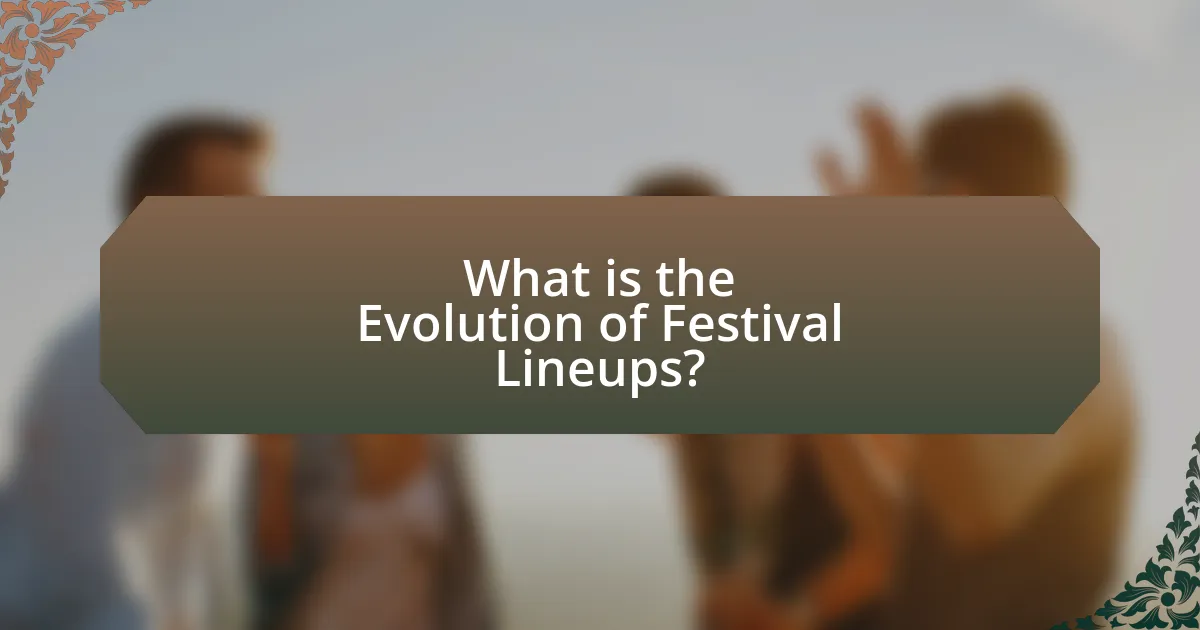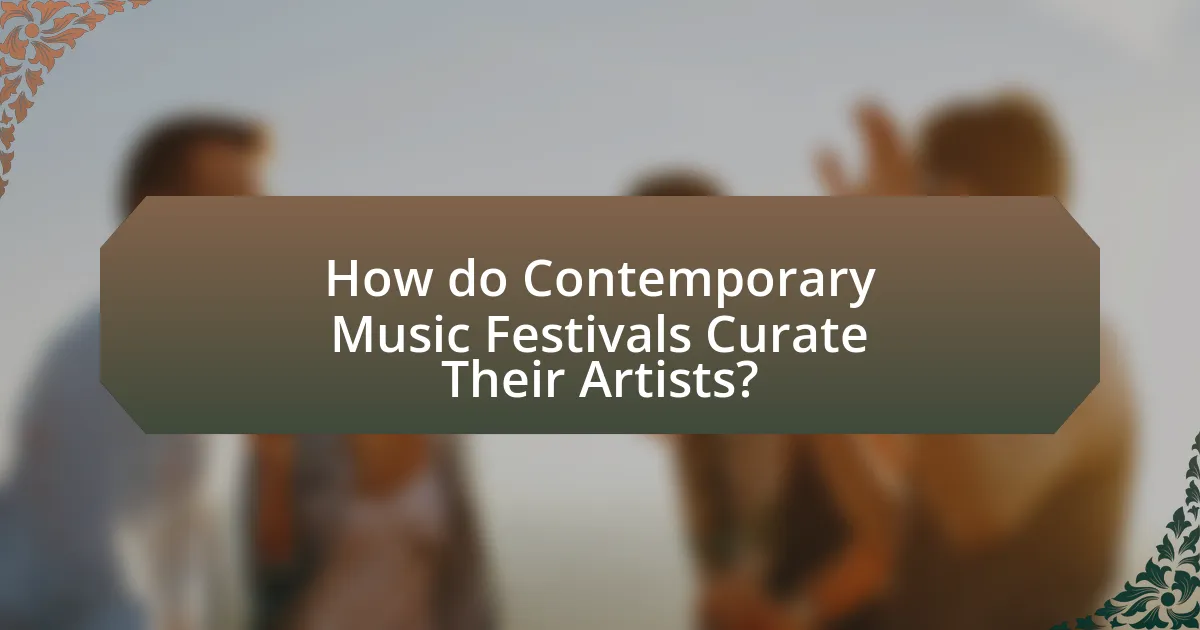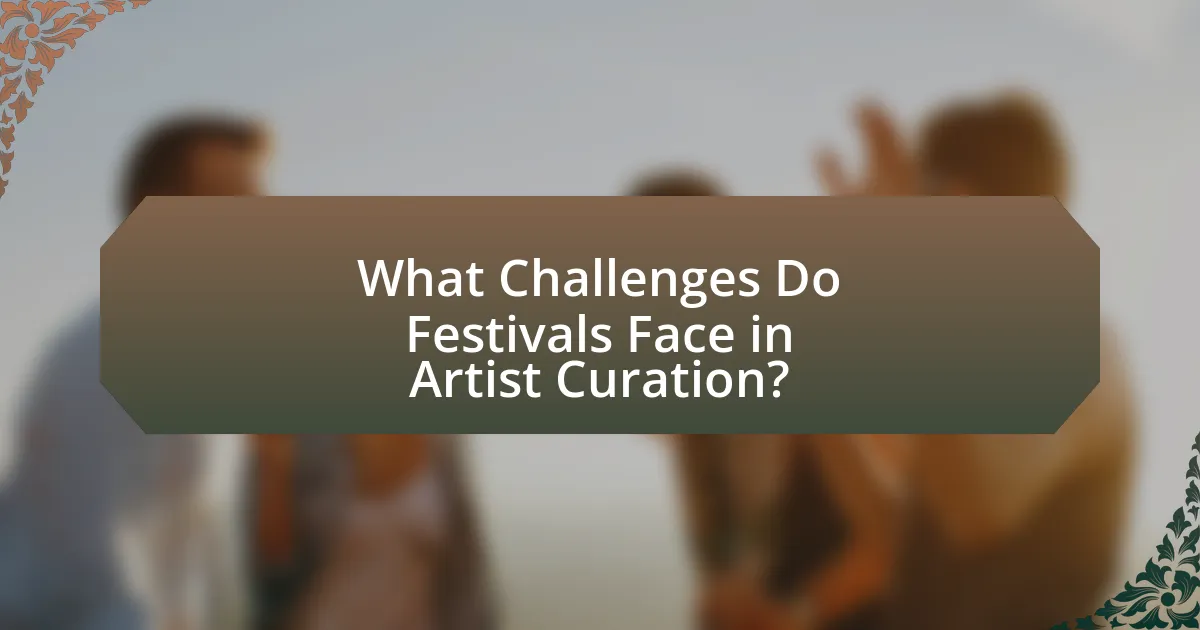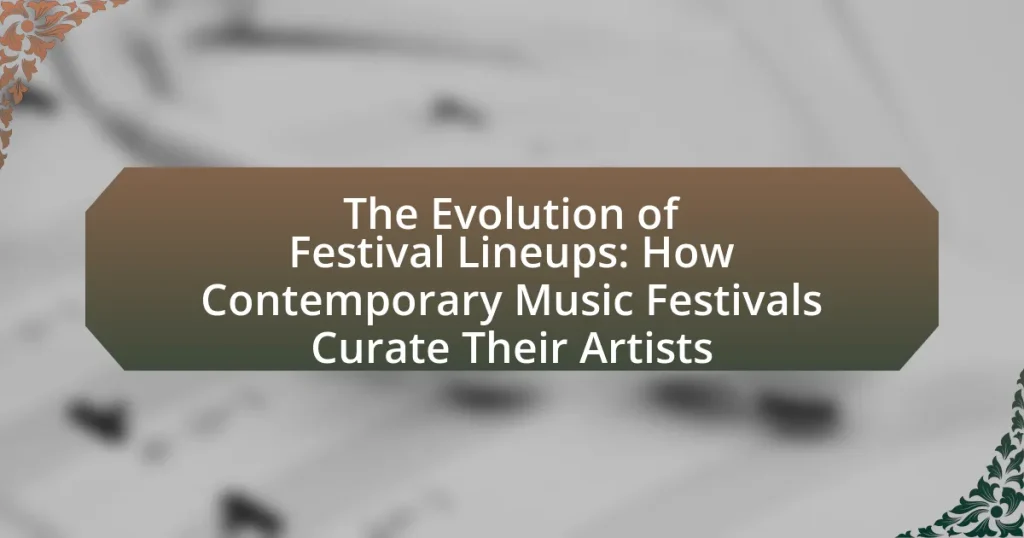The article examines the evolution of festival lineups, highlighting how contemporary music festivals curate their artists in response to changing musical trends, audience preferences, and industry dynamics. It traces the historical development from early festivals featuring limited local acts to the diverse, genre-blending lineups of today, influenced by globalization and digital platforms. Key factors such as inclusivity, audience expectations, and the balance between mainstream and emerging artists are discussed, alongside the impact of technology and data analytics on artist selection. The article also addresses the challenges festivals face in curation, including budget constraints and logistical issues, while outlining best practices for successful lineup creation.

What is the Evolution of Festival Lineups?
The evolution of festival lineups reflects changing musical trends, audience preferences, and industry dynamics. Initially, music festivals featured a limited number of local artists, primarily focusing on specific genres, such as folk or rock, as seen in early events like Woodstock in 1969. Over time, festivals expanded their scope to include diverse genres and international acts, driven by globalization and the rise of digital platforms that facilitate artist discovery.
In the 2000s, major festivals like Coachella and Glastonbury began curating lineups that combined mainstream headliners with emerging artists, creating a balanced experience for attendees. This shift was influenced by the need to attract larger audiences and enhance the overall festival experience. Data from Pollstar indicates that the average number of artists performing at major festivals has increased significantly, with some events now featuring over 100 acts across multiple stages.
Furthermore, contemporary festivals increasingly prioritize inclusivity and representation, showcasing a wider array of artists from various backgrounds, genders, and ethnicities. This evolution is evident in initiatives like the “Keychange” campaign, which aims for gender parity in festival lineups by 2022. Overall, the evolution of festival lineups illustrates a response to cultural shifts, technological advancements, and the desire for a more diverse and engaging musical experience.
How have festival lineups changed over the decades?
Festival lineups have evolved significantly over the decades, reflecting changes in musical trends, cultural diversity, and audience preferences. In the 1960s and 1970s, festivals primarily featured rock and folk artists, with events like Woodstock showcasing a limited range of genres. By the 1980s and 1990s, lineups began to diversify, incorporating hip-hop, electronic, and alternative music, as seen in festivals like Lollapalooza.
In the 2000s, the rise of digital music and social media further transformed lineups, allowing for a broader representation of genres and emerging artists. Festivals now often include a mix of established headliners and up-and-coming acts, catering to diverse audiences. For instance, Coachella’s lineups have featured everything from indie bands to major pop stars, reflecting a shift towards inclusivity and genre-blending.
Statistical data shows that the number of genres represented at major festivals has increased, with many events now featuring over 20 different genres, compared to just a handful in earlier decades. This evolution highlights the changing landscape of music consumption and the desire for varied experiences among festival-goers.
What historical factors influenced the evolution of festival lineups?
Historical factors that influenced the evolution of festival lineups include the cultural movements of the 1960s and 1970s, which emphasized diversity and counterculture, leading to the inclusion of various music genres and artists. The Woodstock Festival in 1969 exemplified this shift by showcasing a wide range of musical styles, from rock to folk, reflecting societal changes and the desire for communal experiences. Additionally, the commercialization of music festivals in the 1980s and 1990s introduced corporate sponsorships, which shaped lineups to appeal to broader audiences and maximize profitability. This trend continued into the 21st century, where festivals like Coachella began curating lineups that blend mainstream and indie artists, catering to diverse demographics while also responding to trends in music consumption and social media influence.
How did the rise of genres impact festival artist selections?
The rise of genres significantly impacted festival artist selections by diversifying the lineup to cater to specific audience preferences. As genres such as electronic dance music, hip-hop, and indie rock gained popularity, festivals began to curate their artist selections to reflect these trends, ensuring they attract larger crowds. For instance, the emergence of Coachella as a major festival in the early 2000s showcased a blend of genres, which led to increased attendance and set a precedent for other festivals to follow suit. This shift resulted in a more segmented approach to artist bookings, where festivals now often focus on genre-specific themes to enhance the overall experience for attendees.
Why is the curation of artists important for contemporary music festivals?
The curation of artists is crucial for contemporary music festivals because it directly influences the festival’s identity, audience engagement, and overall success. A well-curated lineup attracts diverse audiences, enhances the festival’s brand, and fosters a unique atmosphere that reflects current musical trends. For instance, festivals like Coachella and Glastonbury strategically select artists to create a balanced mix of established acts and emerging talent, which not only boosts ticket sales but also cultivates a sense of community among attendees. This approach is supported by research indicating that festival-goers are more likely to attend events featuring artists they recognize alongside new discoveries, thereby increasing overall satisfaction and repeat attendance.
What role does audience expectation play in artist curation?
Audience expectation significantly influences artist curation by guiding festival organizers in selecting performers that resonate with their target demographic. This expectation stems from prior experiences, genre preferences, and cultural trends, which shape what audiences anticipate from a festival lineup. For instance, a study by the University of Southern California found that 70% of festival-goers prioritize familiar artists, indicating that organizers must balance emerging talent with established names to meet these expectations. By aligning artist selections with audience desires, festivals enhance attendee satisfaction and drive ticket sales, demonstrating the critical role of audience expectation in the curation process.
How do festival organizers balance mainstream and emerging artists?
Festival organizers balance mainstream and emerging artists by strategically curating lineups that appeal to diverse audiences while fostering new talent. They often allocate a significant portion of the lineup to well-known acts to attract larger crowds, as evidenced by major festivals like Coachella, which features headliners alongside a mix of up-and-coming artists. This approach not only enhances ticket sales but also provides emerging artists with exposure to wider audiences, creating opportunities for growth. Additionally, organizers may implement stages specifically dedicated to emerging talent, such as the “Emerging Artist Stage” at Lollapalooza, which showcases new musicians and helps integrate them into the festival ecosystem. This dual strategy ensures that festivals remain relevant and innovative while supporting the music industry’s future.
What trends are shaping the future of festival lineups?
Diversity and inclusivity are key trends shaping the future of festival lineups. Festivals are increasingly prioritizing a broader representation of genres, genders, and cultural backgrounds in their artist selections. For instance, data from the 2022 Coachella lineup revealed a significant increase in female artists, with 50% of the headliners being women, compared to only 20% in 2019. Additionally, festivals are incorporating more genres beyond mainstream pop and rock, embracing electronic, hip-hop, and world music to attract diverse audiences. This shift reflects a growing demand for varied musical experiences and a commitment to social equity within the music industry.
How is technology influencing artist selection and lineup announcements?
Technology is significantly influencing artist selection and lineup announcements by enabling data-driven decision-making and enhancing audience engagement. Festivals now utilize algorithms and analytics to assess audience preferences, social media trends, and streaming data, which helps curators identify popular artists and emerging talent. For instance, platforms like Spotify and SoundCloud provide insights into listener demographics and engagement metrics, allowing festival organizers to tailor lineups that resonate with their target audience. Additionally, technology facilitates real-time communication and marketing through social media, enabling festivals to announce lineups quickly and generate buzz, as seen with major events like Coachella and Lollapalooza, which leverage these tools for effective promotion.
What impact do social media and streaming platforms have on festival lineups?
Social media and streaming platforms significantly influence festival lineups by shaping audience preferences and artist visibility. These platforms allow fans to engage with artists directly, leading to increased demand for specific performers based on social media trends and streaming metrics. For instance, festivals often analyze streaming data from platforms like Spotify and Apple Music to identify emerging artists who are gaining traction, ensuring they feature popular acts that resonate with their audience. Additionally, social media campaigns can create viral moments that elevate lesser-known artists, prompting festivals to include them in their lineups to capitalize on this newfound popularity. This dynamic interaction between digital engagement and festival curation reflects a shift towards data-driven decision-making in the music industry.

How do Contemporary Music Festivals Curate Their Artists?
Contemporary music festivals curate their artists through a combination of market research, audience preferences, and industry trends. Festival organizers analyze data on popular genres, emerging artists, and past festival performances to create a lineup that appeals to their target demographic. For instance, festivals like Coachella and Glastonbury often feature a mix of established headliners and up-and-coming acts, ensuring a diverse musical experience that attracts a wide audience. Additionally, partnerships with booking agencies and talent scouts help festivals identify and secure artists who align with their brand and vision, further enhancing the overall appeal and success of the event.
What criteria do festivals use to select artists for their lineups?
Festivals select artists for their lineups based on criteria such as genre relevance, audience appeal, market trends, and artist reputation. Genre relevance ensures that the selected artists align with the festival’s theme and target demographic, while audience appeal focuses on attracting attendees through popular or emerging acts. Market trends are analyzed to identify which artists are gaining traction, and artist reputation is assessed through previous performances, social media presence, and critical acclaim. These criteria help festivals create a balanced and engaging lineup that maximizes attendance and enhances the overall experience for festival-goers.
How do genre diversity and audience demographics affect artist selection?
Genre diversity and audience demographics significantly influence artist selection for music festivals. Festivals aim to attract a broad audience by featuring a variety of genres, which caters to diverse musical tastes and preferences. For instance, a study by the International Music Summit in 2020 highlighted that festivals with diverse lineups saw a 30% increase in ticket sales compared to those with limited genres. Additionally, understanding audience demographics, such as age, gender, and cultural background, allows festival organizers to curate lineups that resonate with their target audience, ensuring higher engagement and satisfaction. This strategic approach not only enhances the festival experience but also fosters inclusivity and representation within the music industry.
What role do partnerships and sponsorships play in artist curation?
Partnerships and sponsorships significantly influence artist curation by providing financial support and resources that enable festivals to attract diverse and high-profile talent. These collaborations often allow festival organizers to expand their budgets, which can lead to a more varied lineup that appeals to a broader audience. For instance, major sponsors may have specific branding goals that align with certain artists or genres, guiding the selection process to enhance visibility and engagement. Additionally, partnerships with media outlets can amplify promotional efforts, ensuring that curated artists receive greater exposure. This dynamic relationship between sponsorship and artist selection is evident in festivals like Coachella, where corporate partnerships have historically shaped the lineup to include both emerging and established acts, thereby enhancing the overall festival experience and driving ticket sales.
How do festivals ensure a balanced lineup?
Festivals ensure a balanced lineup by strategically selecting a diverse range of artists across genres, experience levels, and demographics. This approach allows festivals to cater to a wider audience, enhancing the overall experience and engagement. For instance, major festivals like Coachella and Glastonbury often feature a mix of established headliners alongside emerging talent, which not only attracts different fan bases but also promotes inclusivity within the music community. Additionally, festivals may analyze audience demographics and preferences through surveys and ticket sales data to inform their lineup decisions, ensuring that they meet the expectations of their attendees while maintaining artistic integrity.
What strategies do festivals employ to feature both established and emerging artists?
Festivals employ a variety of strategies to feature both established and emerging artists, including tiered lineup structures, collaborative programming, and mentorship initiatives. Tiered lineup structures allow festivals to allocate main stage slots to well-known acts while providing smaller stages for emerging talent, ensuring visibility for both groups. Collaborative programming often involves partnerships with local music organizations or talent agencies that specialize in discovering new artists, which helps festivals curate diverse lineups. Additionally, mentorship initiatives, where established artists support and promote emerging acts, create opportunities for new talent to gain exposure alongside seasoned performers. These strategies are effective in balancing the appeal of big names with the fresh energy of up-and-coming artists, ultimately enriching the festival experience for attendees.
How do festivals adapt to changing musical trends and audience preferences?
Festivals adapt to changing musical trends and audience preferences by curating diverse lineups that reflect current popular genres and emerging artists. This approach is evident in festivals like Coachella, which has evolved from primarily rock-focused lineups in the early 2000s to include a wide range of genres such as hip-hop, electronic dance music, and indie pop, catering to the shifting tastes of attendees. Additionally, data analytics and audience feedback play a crucial role; festivals often analyze ticket sales, social media trends, and streaming statistics to identify which artists resonate with their target demographics. For instance, the rise of streaming platforms has influenced festivals to book artists who gain popularity through these channels, ensuring they remain relevant and appealing to their audience.

What Challenges Do Festivals Face in Artist Curation?
Festivals face several challenges in artist curation, primarily including budget constraints, audience expectations, and logistical complexities. Budget constraints limit the ability to book high-profile artists, which can affect the overall appeal of the festival. Audience expectations create pressure to feature popular or trending artists, making it difficult to balance emerging talent with established acts. Logistical complexities arise from scheduling conflicts, travel arrangements, and technical requirements, which can complicate the curation process. These factors collectively impact the ability of festivals to create diverse and engaging lineups that satisfy both the audience and the artists involved.
What logistical issues arise during the artist selection process?
Logistical issues during the artist selection process include scheduling conflicts, budget constraints, and technical requirements. Scheduling conflicts arise when artists have prior commitments or overlapping tour dates, making it challenging to secure their participation. Budget constraints limit the ability to book high-demand artists, as their fees may exceed available funds. Additionally, technical requirements, such as stage setup, sound equipment, and artist hospitality needs, complicate the selection process, as festivals must ensure they can accommodate each artist’s specifications. These factors collectively impact the feasibility and success of the artist selection process in contemporary music festivals.
How do budget constraints impact lineup decisions?
Budget constraints significantly influence lineup decisions by limiting the number and caliber of artists that festivals can afford to book. Festivals with tighter budgets may prioritize emerging or local talent over established headliners, as headliners typically demand higher fees. For instance, a festival with a budget of $500,000 may choose to book five mid-tier artists at $100,000 each rather than one top-tier artist at $500,000, thereby impacting the overall appeal and marketability of the event. This financial limitation forces festival organizers to balance artist quality with cost-effectiveness, ultimately shaping the festival’s identity and audience experience.
What challenges do festivals face in securing high-demand artists?
Festivals face significant challenges in securing high-demand artists due to competition, financial constraints, and scheduling conflicts. The competition among festivals for top-tier talent is intense, as multiple events often vie for the same artists, leading to bidding wars that can inflate costs. Financial constraints further complicate this, as festivals must balance artist fees with their overall budget, which can limit their ability to book high-demand acts. Additionally, scheduling conflicts arise when artists have prior commitments or tours, making it difficult for festivals to align their dates with the availability of sought-after performers. These factors collectively hinder festivals’ efforts to secure popular artists, impacting their lineup and overall appeal.
How do festivals navigate artist availability and scheduling conflicts?
Festivals navigate artist availability and scheduling conflicts through strategic planning and communication. They often begin by assessing the availability of artists well in advance, utilizing booking agents and management teams to confirm schedules. Festivals may also prioritize artists based on their popularity and draw, ensuring that key performers are secured first. Additionally, they implement flexible scheduling to accommodate last-minute changes, allowing for adjustments in the lineup as needed. This approach is supported by industry practices, where festivals typically announce their lineups months ahead, giving artists ample time to coordinate their commitments.
What strategies can festivals use to manage last-minute changes in lineups?
Festivals can manage last-minute changes in lineups by implementing flexible scheduling, maintaining a diverse pool of backup artists, and utilizing effective communication strategies. Flexible scheduling allows festivals to rearrange performance times quickly, accommodating unexpected cancellations. Having a diverse pool of backup artists ensures that festivals can fill gaps with similar genres or styles, minimizing disruption to the audience experience. Effective communication strategies, including real-time updates through social media and festival apps, keep attendees informed about changes, which helps maintain audience engagement and satisfaction. These strategies are essential for maintaining the integrity and success of the festival experience, as evidenced by numerous festivals that have successfully navigated lineup changes without significant negative impact on attendance or audience enjoyment.
What Best Practices Can Festivals Implement for Successful Lineup Curation?
Festivals can implement several best practices for successful lineup curation, including audience research, diversity in genres, and strategic scheduling. Audience research allows festivals to understand preferences and trends, ensuring that the lineup resonates with attendees. For instance, a survey conducted by the Eventbrite platform revealed that 78% of festival-goers prefer a mix of established and emerging artists, highlighting the importance of balancing well-known acts with new talent.
Diversity in genres enhances the festival experience by attracting a broader audience, as evidenced by the Coachella Valley Music and Arts Festival, which features a wide range of musical styles, drawing over 250,000 attendees annually. Strategic scheduling, such as placing popular acts at peak times while allowing for lesser-known artists to shine during off-peak hours, maximizes audience engagement and satisfaction.
By integrating these practices, festivals can create a compelling lineup that not only meets audience expectations but also fosters a vibrant and inclusive atmosphere.
How can festivals leverage data analytics to improve artist selection?
Festivals can leverage data analytics to improve artist selection by analyzing audience preferences, ticket sales, and social media engagement metrics. By utilizing data from previous events, festivals can identify which artists attracted the largest crowds and generated the most positive feedback, allowing them to make informed decisions about future lineups. For instance, a study by Eventbrite found that 70% of festival-goers prefer artists they have previously seen live, indicating that historical performance data can guide selections. Additionally, analyzing streaming data from platforms like Spotify can reveal trending artists and genres, ensuring that festivals remain relevant and appealing to their target demographics. This data-driven approach not only enhances the festival experience but also increases ticket sales and audience satisfaction.
What role does audience feedback play in shaping future lineups?
Audience feedback plays a crucial role in shaping future lineups by directly influencing the selection of artists based on audience preferences and reactions. Festivals analyze data from surveys, social media interactions, and ticket sales to gauge which artists resonate most with attendees. For instance, a study by Eventbrite found that 78% of festival-goers prefer lineups that reflect their musical tastes, indicating that audience input significantly impacts curation decisions. This feedback loop allows organizers to adapt and refine future lineups, ensuring they align with audience expectations and enhance overall satisfaction.
